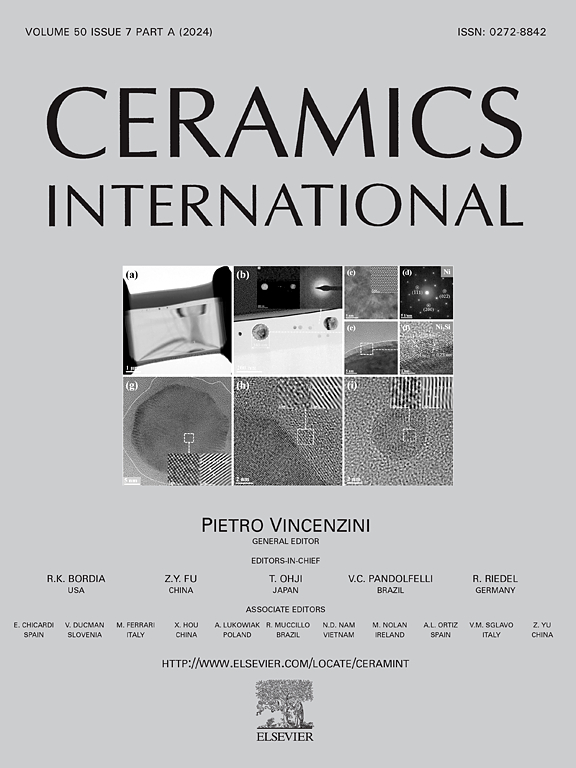热处理结晶对不同生物活性玻璃浸润改性Y-TZP陶瓷理化生物学性能的影响
IF 5.1
2区 材料科学
Q1 MATERIALS SCIENCE, CERAMICS
引用次数: 0
摘要
本文研究了不同成分的生物活性玻璃(BGs)对钇稳定的四方氧化锆多晶(Y-TZP)陶瓷进行热处理后的理化和生物学性能的影响。Y-TZP陶瓷通过浸涂工艺构建多孔表面层,然后进行BG溶胶渗透和随后的热处理。结果表明,浸渗和热处理导致BGs内形成不同的结晶相,同时保留了Y-TZP的四方相。表面修饰可显著增强蛋白质吸附,优化离子释放行为,促进细胞增殖。在不同的BG成分中,77S BG浸润的Y-TZP陶瓷对小鼠骨髓间充质干细胞(mBMSCs)的快速成骨分化表现出较好的促进作用。这些结果表明,表面多孔Y-TZP层的构建和BGs在Y-TZP陶瓷中的整合具有提高种植体生物活性和临床性能的潜力。本文章由计算机程序翻译,如有差异,请以英文原文为准。

Effects of crystallization via heat treatment on the physicochemical and biological properties of Y-TZP ceramics modified by infiltration with different bioactive glasses
This study investigates the effects of crystallization via heat treatment on the physicochemical and biological properties of yttria-stabilized tetragonal zirconia polycrystal (Y-TZP) ceramics modified through the infiltration of bioactive glasses (BGs) with different compositions. Y-TZP ceramics underwent a dip-coating process to construct a porous surface layer, followed by BG sol infiltration and subsequent heat treatment. The results demonstrate that infiltration and heat treatment led to the formation of distinct crystalline phases within the BGs, while preserving the tetragonal phase of Y-TZP. Surface modification significantly enhanced protein adsorption, optimized ion release behavior, and promoted cell proliferation. Among the various BG compositions, Y-TZP ceramics infiltrated with 77S BG exhibited superior performance in promoting rapid osteogenic differentiation of mouse bone marrow mesenchymal stem cells (mBMSCs). These findings suggest that the construction of surface porous Y-TZP layer and the integration of BGs into Y-TZP ceramics hold potential for enhancing the bioactivity and clinical performance of dental implants.
求助全文
通过发布文献求助,成功后即可免费获取论文全文。
去求助
来源期刊

Ceramics International
工程技术-材料科学:硅酸盐
CiteScore
9.40
自引率
15.40%
发文量
4558
审稿时长
25 days
期刊介绍:
Ceramics International covers the science of advanced ceramic materials. The journal encourages contributions that demonstrate how an understanding of the basic chemical and physical phenomena may direct materials design and stimulate ideas for new or improved processing techniques, in order to obtain materials with desired structural features and properties.
Ceramics International covers oxide and non-oxide ceramics, functional glasses, glass ceramics, amorphous inorganic non-metallic materials (and their combinations with metal and organic materials), in the form of particulates, dense or porous bodies, thin/thick films and laminated, graded and composite structures. Process related topics such as ceramic-ceramic joints or joining ceramics with dissimilar materials, as well as surface finishing and conditioning are also covered. Besides traditional processing techniques, manufacturing routes of interest include innovative procedures benefiting from externally applied stresses, electromagnetic fields and energetic beams, as well as top-down and self-assembly nanotechnology approaches. In addition, the journal welcomes submissions on bio-inspired and bio-enabled materials designs, experimentally validated multi scale modelling and simulation for materials design, and the use of the most advanced chemical and physical characterization techniques of structure, properties and behaviour.
Technologically relevant low-dimensional systems are a particular focus of Ceramics International. These include 0, 1 and 2-D nanomaterials (also covering CNTs, graphene and related materials, and diamond-like carbons), their nanocomposites, as well as nano-hybrids and hierarchical multifunctional nanostructures that might integrate molecular, biological and electronic components.
 求助内容:
求助内容: 应助结果提醒方式:
应助结果提醒方式:


